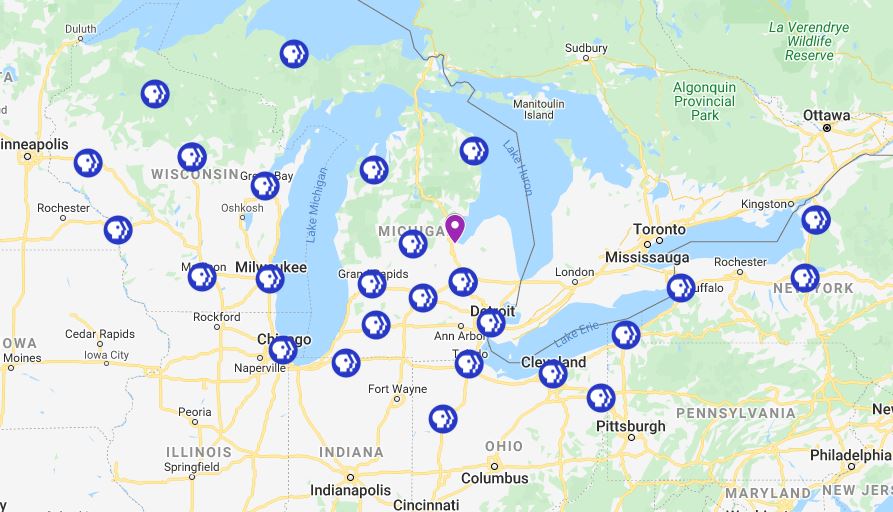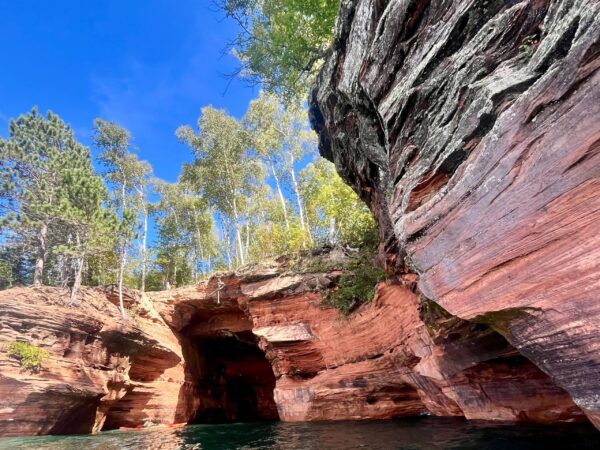
This is part of a series in which the Great Lakes Now staff looks back on 2020.
It’s probably futile to try to find ONE moment that captures 2020 for Great Lakes Now, at least from my view today at my dining room table/desk on a grey winter day.
If we did one thing – and the “we” includes our staff, DPTV teammates, GLN freelancers, network of PBS stations that carry the show, media collaborators and community partner organizations – in 2020, we grew.
And it was mostly in positive ways, not like the algal blooms in Lake Erie or invasive mussel populations in most of the Great Lakes…
We tackled the topics you’re interested in.
When we got the embargoed copy of the Triennial Progress Report in advance of the International Joint Commission’s meeting, we read that the top public concerns around the region were climate change, invasive species and chemical pollutants.
Well, this year we did a whole show called “From Rust to Resilience: What climate change means to Great Lakes cities,” in collaboration with several media outlets. It even won an award. And the lake levels have been the subjects of several segments and stories on the website.
We tackled algal blooms in Lake Erie and their link to agriculture (hint: your dairy and meat consumption is fueling them…), and we went underwater a couple times to see mussels and gobies.
From Rust to Resilience – Great Lakes Now Episode 1013
Feeding the Blooms – Great Lakes Now Episode 1016 – Segment 1
Invaders on the Menu – Great Lakes Now Episode 1020 – Segment 3
We added people who bring you Great Lakes-related digital, video and engagement.
Supervising Producer Rob Green came on full-time in a staff position in February, and he continues to add talented videographers and producers to the roster that makes the monthly show. Plus, he’s not afraid to tackle any topic – just read his year-in-review piece when it comes out tomorrow.
News Director Natasha Blakely found some new writers, supervised some talented interns, started working regularly with our new Great Lakes News Collaborative team, and shared stories through the Covering Climate Now initiative. She even found time to write a little bit. In other words, the trusted sources of stories for this website grew.
Natasha’s Favorite 2020 Work By Herself: “Saving the Great Lakes”: National Geographic December issue explores the lakes and their struggles
By Someone Else: Dam Investment: How does Michigan stack up against Great Lakes peers?
DPTV Social Media Manager Colleen O’Donnell added Great Lakes Now to her endless to-do list, and she’s responsible for developing our watch parties that Detroit Public TV Producer Zach Allen also makes happen on the tech side. (More on that below.) Our followers on all of our social media platforms are, you guessed it, growing.
Watch Party Playlist is HERE.
And within DPTV, even more staff from more departments help with raising money, getting people paid, support the tech, sending program offers to other stations and a million other things that are a “normal” part of any business’s operations.
PBS stations joined our Great Lakes “network.”

More stations are carrying the program more often. (See graph.) When we launched in April 2019, we had a handful of stations in a few states carrying the program. To date, we’ve been carried by PBS affiliates in seven of the eight Great Lakes states.
With PBS Wisconsin airing our series beginning Oct. 1, that gives us complete coverage in Wisconsin and Michigan on PBS channels.

Viewers who live along the Great Lakes in Indiana, Pennsylvania and most of New York also can see the show on their local PBS channels.
And in late December, we got word that the PBS station in Santa Barbara, Calif., Empire PBS – WKVCR, will carry our “River Influence” episode at the end of January. That’s the first time a station out of the Great Lakes region has carried the program – and we’re pretty excited to tell the West Coast the stories from the Third Coast.
“Virtual” meant more events and more partners.
Moving outside of our own station domain, we added new organizations to co-host events with us.
GLN staff spoke to students in Boston, scientists in Winnipeg, at-home learning sessions in Minneapolis, film fans at festivals, teachers at conferences, journalists in eastern Europe, collaborative media managers in the U.S. and around the world, yacht club members in Detroit, Ohio hunters and anglers on a radio program, and audiences who follow us on Facebook.
Some of these events were in person, right up to March 12. Then we went online. And in July we launched our Facebook Watch Party series, thanks to social media manager Colleen O’Donnell.
Like anyone who’s had tech problems on a Zoom work, school or social session, we survived glitches on this new platform. In our Facebook watch parties, you forgave our bad audio, missing audio and glitchy video, and you asked questions, shared stories and watched the archived versions of these events.
Each Detroit Public TV broadcast of our monthly show has a watch party – find them HERE on our Facebook Events Page.
And then you can find the archived versions on our YouTube Channel. (Subscribe while you’re there!)
The Watch Parties have turned into a regular “thing” with the Belle Isle Conservancy and WDET-FM. Each first Friday we chat, show a segment from the show and talk to an expert about how the subject of the segment is impacting the Detroit River.
So what have we got in store for 2021?
We saw our Canadian audience grow on our website in 2020, and we’d like to keep that momentum. Look for more stories with datelines in our neighbor to the north.
Our monthly show is going to start 2021 with a look at what the new occupant of the White House means to the Great Lakes. Spoiler Alert: Not too many people are complaining … yet. And when the pandemic restrictions loosen, we’ll get our host out exploring the Great Lakes and you can go along like you did on the Westcott mail boat.
Our website is going to continue to bring you timely news and in-depth stories from around the region, looking at issues, topics, events and people.
And we will continue to host events on our own platforms, co-host with our partners around the region and maybe even venture to some other states or countries. Virtually of course. That’s in the works.
In 2021, we’ll continue to help audiences understand how to be good stewards of these amazing freshwater system, but we’ll give you context for what’s in balance between the ecosystem and economic development, history and modern life.
Thank you for being part of it.
Now I’m going to go partake in some adult beverages made with Great Lakes water and wash down some Lake Superior whitefish dip.
Here’s to a safe, healthy, freshwater 2021.
For more on Great Lakes Now in 2020, click through this interactive timeline:
Read 2019’s staff lookbacks:
Superior Crossing: Sailing across the biggest, deepest and coldest Great Lake
An Open Letter: I have been seeing lake sturgeon and plan to keep it up in 2020
4 out of 5: I’ll get you next time, Lake Ontario
The Great Lakes in 2019: Senior Correspondent Gary Wilson’s look back at the headlines
Great Lakes Now: Our 2019 look back and our 2020 look ahead
Or read some real news on Great Lakes Now:
Pipelines and Plastic Bottles: Michigan advocate focuses on Line 5 and Nestle bottled water issue
Field Tiles: Continued use and improvement of drainage systems pose problems for Lake Erie
Family-owned fishing businesses displaced by waterfront developments on Great Lakes
API key not valid. Please pass a valid API key.Featured image: Sandra Svoboda (Photo courtesy of Sandra Svoboda)




